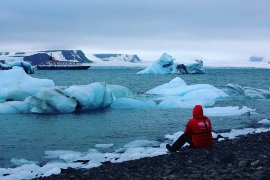Simultaneous significant warming was recorded at the North and South poles of the planet – the temperature at the Antarctic Concordia station, located at an altitude of 3234 meters above sea level, reached −12.2°C the day before, which is 40°C above average.
An increase in temperature was also recorded at Vostok station in Antarctica: −17.7°C, which is almost 15°C more than the maximum temperature previously recorded in March, reports the Associated Press. There are now different seasons of the year at the poles. The North and South Poles should not melt at the same time. Warming in Antarctica is most likely a random weather phenomenon that is not associated with climate warming. Apparently, this is a warm atmospheric flow that came from the Pacific Ocean, scientists say.
According to the American Institute of Climate Change at the University of Maine, last week around the world was abnormally warm: temperatures on the planet as a whole exceeded the norm by 0.9 degrees, in Antarctica – by 4.4, in the Arctic – by 5.6. Scientists associate the sharp short-term warming of the air at the poles with powerful atmospheric heat waves that came to the polar regions. And the fact that they formed simultaneously in the Southern and Northern Hemispheres is, according to climatologists, a coincidence.
The Arctic is experiencing more intense warming than the global average and is expected to intensify by the end of the 21st century. One of the consequences of such uneven climate change has been the rapid degradation of permafrost on land. Its seasonally melted layer increases every year, putting the infrastructure of entire cities in the Arctic at risk of destruction and leading to emissions of thermogenic methane. In 2014, a 25-meter crater similar to a meteorite impact was discovered on the Yamal Peninsula, and in subsequent years several more such craters were found in the region.
From 2010 to 2019, the layer of underwater permafrost on the shelf of Canada’s Beaufort Sea became thinner by an average of nine meters. Repeated bathymetric surveys made it possible to detect morphological changes in the structure of the coast and the adjacent bottom – worn down ridges, hollows and basins, reports the journal Proceedings of the National Academy of Sciences.
Overall, the Arctic is warming two to three times faster than the rest of the globe, and this is reflected in the annual loss of sea ice. And the Southern continent, with the exception of the Antarctic Peninsula, until recently did not react much to global warming. In the same year, the poles seemed to change places: the area of Antarctic ice was the maximum in the last five years, and the Arctic ice was the minimum.
In addition, glaciers located on mountain peaks around the world are melting almost everywhere with rare exceptions, the first time this has happened on the planet in 2,000 years, the International Panel on Climate Change has found. During the last five-year period, Elbrus glaciers began to degrade 5 times faster, losing 1.25 square meters each. km per year. The greatest loss of area was recorded for glaciers with their maximum width: Dzhikiugankez (4.5 km) and Bolshoi Azau (3 km) on the slopes of Elbrus.
Climate change also threatens the collapse of glaciers in the Caucasus. A large number of rock falls in the Western and Central Caucasus can move glaciers and trigger their collapse, which may indicate that movement and collapse of other glaciers that are not considered pulsating are possible in the future.





